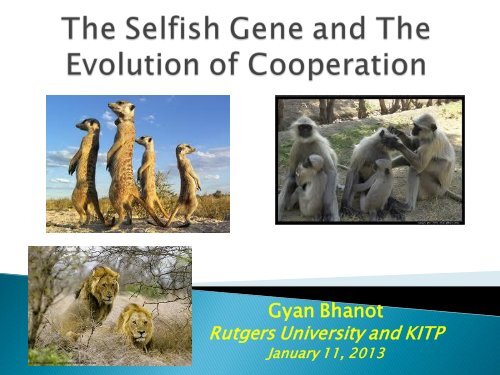The Selfish Gene and The Evolution of Cooperation - Online.itp.ucsb ...
The Selfish Gene and The Evolution of Cooperation - Online.itp.ucsb ...
The Selfish Gene and The Evolution of Cooperation - Online.itp.ucsb ...
You also want an ePaper? Increase the reach of your titles
YUMPU automatically turns print PDFs into web optimized ePapers that Google loves.
Gyan Bhanot<br />
Rutgers University <strong>and</strong> KITP<br />
January 11, 2013
◦ Identify an interesting problem to work on
Why are we selfish?<br />
Why do we co-operate?<br />
Is cooperation an emergent phenomenon,which<br />
can be influenced/guided?<br />
Relevance: <strong>The</strong> answers to these questions<br />
connect biology, sociology, anthropology,<br />
morality/religion/ethics, behavioral psychology,<br />
business practices <strong>and</strong> politics !
Is Religion necessary for Moral<br />
behavior?<br />
Or does cooperation emerge<br />
naturally in a world <strong>of</strong> egotists<br />
without central authority?
Nature is dominated by selfish individuals<br />
who compete on ruthless terms<br />
“life is solitary, poor, nasty, brutish <strong>and</strong><br />
short.”<br />
<strong>Cooperation</strong> cannot emerge without a central<br />
authority because:<br />
A strong government is necessary.
Altruism: behavior which increase another<br />
entity’s welfare at the expense <strong>of</strong> ones own<br />
<strong>Selfish</strong>ness: behavior which increase an<br />
entity’s welfare at the expense <strong>of</strong> all others it<br />
encounters.<br />
Welfare = “Chance <strong>of</strong> Survival” or “Chance for<br />
Reproductive Success”
Meerkats (Kalahari) Share Baby sitting<br />
duties<br />
Colobus Monkeys sharing food<br />
Budgies sharing fruit
If we are told <strong>of</strong> a man who lived <strong>and</strong><br />
prospered amongst gangsters, we would infer<br />
that he is: tough, ruthless, with a quick<br />
trigger finger & the ability to attract loyal<br />
friends<br />
We can deduce a woman/man/animal’s<br />
nature from the conditions under which<br />
she/he survived <strong>and</strong> prospered
Like successful New York gangsters, our<br />
genes have survived for millions <strong>of</strong> years by<br />
competing with each other<br />
We are “Survival Machines” created by genes<br />
<strong>The</strong> pre-eminent quality to expect from the<br />
genes is ruthless selfishness
Black-headed gulls eat chicks<br />
from neighboring nests when<br />
parents are away<br />
Praying Mantis female eats<br />
male after mating<br />
Penguins in the Antarctic<br />
push other penguins <strong>of</strong>f ice<br />
to test if seals are in the<br />
water before jumping in<br />
to feed.
This does not mean our morality is, or should be,<br />
based on what genes do.<br />
<strong>Gene</strong>tics <strong>and</strong> <strong>Evolution</strong>ary theory do not say how<br />
humans ought to behave.<br />
“One should distinguish between what IS the<br />
case, from what we wish to believe SHOULD be<br />
the case.“<br />
Morality is merely one choice among possible <strong>of</strong><br />
behavioral phenotyes.
When worker bees sting<br />
honey robbers, vital organs<br />
are torn out <strong>and</strong> the bees die.<br />
Ground nesting birds perform<br />
a “distraction display” when a<br />
predator approaches<br />
– to lure it away from<br />
its nestlings
Angler fish <strong>and</strong> lure<br />
leaf mimic frog<br />
Dead leaf Mantis<br />
Leaf mimic fish<br />
Bee <strong>and</strong> Bee Orchid<br />
Eucalyptus Leaf Insect
Animals spend time <strong>and</strong> energy in reproduction<br />
<strong>and</strong> nurture<br />
This is wrongly labeled “Perpetuation <strong>of</strong> the<br />
Species” – which is the consequence & not the<br />
motivation for reproduction<br />
A slight (false) stretch <strong>of</strong> logic then deduces<br />
that the “function” <strong>of</strong> reproduction is “to”<br />
perpetuate the species<br />
<strong>The</strong> final error is to conclude that animals<br />
“behave” so as to “perpetuate the species”
In a group <strong>of</strong> altruists, there is always a<br />
dissenting minority who will refuse to make<br />
sacrifices.<br />
This minority is likely to have better<br />
reproductive success.<br />
<strong>The</strong>ir progeny will inherit “selfish genes”<br />
After several generations <strong>of</strong> natural selection,<br />
these “rebels” will out-compete the altruists.
In tune with political <strong>and</strong> moral ideas that<br />
make us honor <strong>and</strong> admire those who put the<br />
welfare <strong>of</strong> others before their own<br />
However, we are altruistic within a group<br />
(family, clan, language/national group) <strong>and</strong><br />
selfish between groups. <strong>The</strong> latter is the voice<br />
<strong>of</strong> the “selfish gene”.
<strong>Gene</strong> Survival<br />
◦ Kinship recognition<br />
◦ Reciprocal benefit<br />
Expectation/certainty <strong>of</strong> Reward/Punishment<br />
Nurture<br />
Culture (language, heritage, religion,<br />
tradition)<br />
Imprinting/education
<strong>The</strong> original life form was most likely an RNA<br />
molecule (a replicator) which could copy itself.<br />
Over time, because <strong>of</strong> mutations, many types<br />
<strong>and</strong> numbers <strong>of</strong> replicators evolved.<br />
Finite resources <strong>and</strong> natural selection led to a<br />
variety <strong>of</strong> replicator types<br />
Fitness depended on longevity, fecundity,<br />
accuracy <strong>of</strong> replication <strong>and</strong> reproductive<br />
success
PROTOTYPE OF<br />
A REPLICATOR
Consisted <strong>of</strong> stable varieties <strong>of</strong> replicator<br />
molecules.<br />
◦ Were they “alive”?<br />
◦ What does that mean?<br />
<strong>The</strong>y “competed” for survival via natural<br />
selection.<br />
Almost certainly there were predator replicators<br />
So some built enclosures (cell walls) to protect<br />
themselves
Replicator containing cells became complex<br />
Over time, they evolved methods to store<br />
(DNA), retrieve (Polymerase, Ribosomes) <strong>and</strong><br />
process (signaling pathways) information to<br />
perpetuate their replicators<br />
<strong>The</strong>y invented ways <strong>of</strong> increasing stability <strong>and</strong><br />
eliminating rivals<br />
<strong>The</strong>y built “survival machines” (us) to live in.
Sets <strong>of</strong> genes regulate different functions<br />
This program is set soon after fertilization<br />
<strong>and</strong> is tissue specific<br />
It is regulated <strong>and</strong> can be globally modified<br />
It is inherited when cells replicate (mitosis)<br />
Some genes are “imprinted”<br />
<strong>The</strong>re are even “interference genes” <strong>and</strong><br />
“killer genes”
Highest priorities: Survival <strong>and</strong> Reproduction<br />
<strong>Gene</strong>s cooperate to achieve these ends<br />
◦ Find <strong>and</strong> catch/gather food<br />
◦ Avoid being caught <strong>and</strong> eaten<br />
◦ Avoid disease <strong>and</strong> accidents<br />
◦ Protect themselves from the environment<br />
◦ Survive !
SMs who learn by “Trial <strong>and</strong> Error” get hurt.<br />
SMs who process sensory data <strong>and</strong> “simulate”<br />
the world anticipate danger <strong>and</strong> are fitter.<br />
“Simulating Brains” took charge <strong>of</strong> the day to<br />
day running <strong>of</strong> the SMs.
“Consciousness” may have appeared when the<br />
Brain’s “simulation” <strong>of</strong> the world included a<br />
model <strong>of</strong> itself.
Over 4,000,000,000 years,<br />
Survival Machines (SMs)<br />
became elaborate <strong>and</strong> diverse!<br />
Replicators became immortal,<br />
swarming in huge colonies,<br />
safe inside gigantic lumbering<br />
robots (us), manipulating<br />
them by remote control !
Communication = When SMs can influence<br />
behavior <strong>of</strong> other SMs<br />
◦ Language, literature, culture, & institutions to<br />
influence other human beings<br />
◦ Bird song, cricket’s chirp, firefly’s glow<br />
◦ Bees dance in the dark to communicate<br />
◦ babies cry to attract attention<br />
◦ Peacock tails, blushing, bilateral symmetry signal<br />
strength <strong>and</strong> health
No, genes remain primary policy makers.<br />
Brains are only executives<br />
As brains took over control, the genes gave<br />
them a single overall policy instruction<br />
DO WHATEVER YOU CAN TO KEEP US ALIVE<br />
<strong>The</strong> Soma is the “Instrument”, the Germ Line is<br />
the “Treasure.”
Honey bee grubs have a<br />
disease called foul brood<br />
In Hygenic strains, workers<br />
find infected grubs, uncap cells<br />
& throw grubs out. Susceptible strains don’t do this<br />
Rothenbuhler crossed these two strains <strong>and</strong> got three<br />
types: hygenic, non-hygenic <strong>and</strong> a type that<br />
uncapped the cells but did not throw out grubs.<br />
When he uncapped the cells himself, half the nonhygenic<br />
bee crosses threw the grubs out !<br />
Conclusion: <strong>The</strong>re are two “recessive” genes: one for<br />
uncapping <strong>and</strong> one for throwing grubs out.
Similar = “SMs likely to carry the same genes”<br />
Kinship Coefficient = (½) g , g = generation distance<br />
◦ Identical twins: 1, Siblings: ½, parent/child : ½,<br />
Uncles/aunts ¼, first or second cousins: 1/8 or 1/16,<br />
Parental care is “kin altruism”. We should care<br />
as much for a baby sister/brother as a child.<br />
Is “Kin Selection” effectively “Group<br />
Selection”? Or is it all semantics?
Suppose I find 8 fruits each <strong>of</strong> value 6<br />
But I can only eat three <strong>of</strong> them.<br />
◦ Should I eat 3 <strong>and</strong> keep quiet (<strong>and</strong> maybe eat them<br />
later)<br />
◦ Or should I eat two <strong>and</strong> give 2 each to : 1 Brother, 1<br />
Cousin <strong>and</strong> one stranger (kinship 1/2, 1/8 <strong>and</strong> 0)<br />
Score if I eat three = 6 x 3 = 18<br />
Score if I share=12x1+12x1/2+12x1/8=19 ½<br />
SOMETIMES SHARING IS BETTER (has higher<br />
pay<strong>of</strong>f) !
Just as we do not calculate the trajectory <strong>of</strong> a<br />
ball before we catch it.<br />
Our brains automatically make such decisions<br />
based on<br />
◦ Past experience<br />
◦ Expectation <strong>of</strong> future reward (reciprocal altruism)<br />
◦ Physical & Chemical cues (instinctive underst<strong>and</strong>ing <strong>of</strong><br />
relatedness)<br />
◦ Chance to replicate genes<br />
◦ Fear, prejudice, self delusion, brainwashing ….
It is just a framework to organize ideas <strong>and</strong><br />
interpret data.
Price war between stores (both have incentive<br />
to cut prices to attract customers – but if<br />
both cut prices, both lose)<br />
Two lions sharing a kill (both have an<br />
incentive not to share, but if they fight, both<br />
get hurt)<br />
Trade barriers between nations (lowering<br />
barriers improves trade, but if only one does<br />
it, the other wins – so barriers tend to stay)
Two prisoners are asked to confess<br />
If both confess, they go to jail for 5 years<br />
(pay<strong>of</strong>f = 1)<br />
If both don’t confess, they<br />
get a light sentence<br />
(pay<strong>of</strong>f = 3)<br />
If one confesses, he<br />
goes free (pay<strong>of</strong>f = 5),<br />
but the other gets a heavy<br />
sentence (pay<strong>of</strong>f = 0)
COLIN<br />
ROSE<br />
A<br />
Don’t confess<br />
B<br />
Confess<br />
A<br />
Don’t confess (3, 3) (0,5)<br />
B<br />
Confess (5,0) (1,1)
ROSE<br />
COLIN<br />
A<br />
Don’t<br />
confess<br />
B<br />
Confess<br />
A<br />
Don’t<br />
3 0<br />
confess<br />
B<br />
Confess 5 1
ROSE<br />
COLIN<br />
A<br />
Don’t confess<br />
B<br />
Confess<br />
A<br />
Don’t confess 3 5<br />
B<br />
Confess 0 1
COLIN<br />
ROSE<br />
A<br />
Don’t confess<br />
B<br />
Confess<br />
A<br />
Don’t confess (3, 3) (0,5)<br />
B<br />
Confess (5,0) (1,1)
Rational, <strong>Selfish</strong> behavior<br />
<strong>of</strong>ten gives lower pay<strong>of</strong>f<br />
SOMETIMES IT IS BETTER TO<br />
COOPERATE
• T > R > P > S (BB is Stable because T>R, P>S)<br />
• R>(S+T)/2 (AA is Optimal :better than AB, BA)<br />
ROSE<br />
COLIN<br />
A<br />
Don’t confess<br />
B<br />
Confess<br />
A<br />
Don’t confess<br />
R = Reward for<br />
cooperation<br />
(R, R)<br />
T = Temptation<br />
S = Suckers pay<strong>of</strong>f<br />
(S, T)<br />
B<br />
Confess<br />
S = Suckers pay<strong>of</strong>f<br />
T = Temptation<br />
(T,S)<br />
P = Punishment for<br />
mutual defection<br />
(P,P)
If the number <strong>of</strong> games is finite <strong>and</strong> known,<br />
then both will choose BB<br />
But if the number <strong>of</strong> games is uncertain,<br />
things change<br />
If p = probability to play one more game,<br />
AA is stable if p > (T-R)/(T-P) = ½ (for our<br />
choice <strong>of</strong> parameters)<br />
IF END OF PLAY IS UNCERTAIN, COOPERTION<br />
IS THE BEST STRATEGY<br />
T>R>P>S, R>(T+S)/2<br />
(R,R)<br />
(T,S)<br />
(S,T)<br />
(P,P)
1984, Robert Axelrod: 14 programs played<br />
Prisoner’s dilemma 200 times against each<br />
other.<br />
Winning Program was “TIT FOR TAT”<br />
◦ Start by choosing A<br />
◦ In each round, choose whatever the opponent chose<br />
in the previous round<br />
Repeating the contest with 62 programs gave<br />
same result, even though some were<br />
designed to do well against “TIT FOR TAT.”
Nice: Starts by cooperating, never defects<br />
first (friendly)<br />
Retaliatory: Punishes defection immediately<br />
(strong)<br />
Forgiving: Willing to cooperate again (kind)<br />
Clear: Pattern <strong>of</strong> play is consistent <strong>and</strong> easy<br />
to predict (trustworthy)
Player 2<br />
Hawk Dove<br />
Player 1<br />
Hawk (-25,-25) (50,0)<br />
Dove (0,50) (15,15)<br />
John Maynard Smith <strong>and</strong><br />
G. R. Price (1973)<br />
Resource worth 50<br />
Hawks fight<br />
Doves posture & give in<br />
HxH: Injury cost = -100<br />
DxH or HxD: H wins<br />
DxD: Wasted time cost = -20
Player 2<br />
Hawk Dove<br />
Player 1<br />
Hawk (-25,-25) (50,0)<br />
Pure strategies<br />
All Doves, unstable to invasion by<br />
Hawks<br />
All Hawks, unstable to invasion by<br />
Doves (0 points)<br />
Dove (0,50) (15,15)<br />
<strong>Evolution</strong>arily Stable<br />
Strategy (ESS):<br />
BE A HAWK 7 out <strong>of</strong> 12<br />
Times, else be A DOVE<br />
60<br />
50<br />
40<br />
30<br />
20<br />
10<br />
0<br />
-10<br />
-20<br />
-30<br />
0 0.2 0.4 0.6 0.8 1<br />
Hawk fraction<br />
Dove pay<strong>of</strong>f<br />
Hawk pay<strong>of</strong>f
Player 2<br />
Player 1<br />
scores:<br />
Hawk Dove Bully<br />
Hawk -25 50 50<br />
Dove 0 15 0<br />
Bully 0 50 25<br />
Bully Strategy: Fight<br />
if opponent does<br />
not fight back. Else<br />
run away.<br />
Bullies dominate<br />
Doves<br />
Doves die out.<br />
BUT ONE CAN BE A RETALIATOR:<br />
Retaliator Strategy: Behave like a Dove.<br />
However, if persistently attacked, fight<br />
back with ALL YOUR STRENGTH.
Player 1<br />
Player 2<br />
Hawk Dove Bully Retaliator<br />
Hawk -25 50 50 -25<br />
Dove 0 15 0 15<br />
Bully 0 50 25 0<br />
Retaliator -25 15 50 15<br />
100% Retaliators is an ESS.<br />
Doves + Retaliators (Doves < 30%) is also an ESS<br />
Posturing works only if you can fight when provoked
Player 1<br />
Player 2<br />
Hawk Dove Bully Retaliator Bourgois<br />
Hawk -25 50 50 -25 12.5<br />
Dove 0 15 0 15 7.5<br />
Bully 0 50 25 0 25<br />
Retaliator -25 15 50 15 -5<br />
Bourgois -12.5 32.5 25 -5 25<br />
Bourgois Strategy: Be a hawk in your own territory, a dove in<br />
someone else’s territory. Bourgois Pay<strong>of</strong>f = ½ (Hawk+Dove)<br />
ESS: Retaliators with some doves coexisting, Bourgois<br />
with some Bullies coexisting
Colin<br />
Rose<br />
A<br />
B<br />
Zero Sum Game<br />
If both play simultaneously,<br />
Optimum: Rose : ( 5/8 A, 3/8 B) , V opt (R) = 3/2<br />
Colin : ( 1/2 A, 1/2 B) , V opt (C) = -3/2<br />
A (-3,3) (0,0)<br />
But if they play successively, First player loses<br />
(i.e. first player always has V
1941-<br />
1958 -<br />
1943 -
1936 -<br />
1943 -









